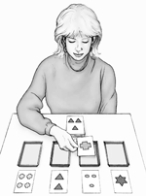A) angiography
B) magnetoencephalography
C) positron emission tomography
D) structural magnetic resonance imaging
E) functional MRI
Correct Answer

verified
Correct Answer
verified
Multiple Choice
Reversible lesions can be produced by microinjection directly into the target brain structure of a
A) local anesthetic such as lidocaine.
B) a micro knife blade.
C) coolant followed by antifreeze.
D) both A and B
E) both B and C
Correct Answer

verified
Correct Answer
verified
Short Answer
In the open-field test, fearful rats are __________, that is, they stay near the walls of the test box.
Correct Answer

verified
Correct Answer
verified
Multiple Choice
Vestibular function can be assessed by assessing a patient's reaction to
A) facial nerve stimulation.
B) electroencephalography.
C) cold water flushed in the ear.
D) needles inserted in the face.
E) needles inserted in the foot.
Correct Answer

verified
Correct Answer
verified
Multiple Choice
The signals in the first few milliseconds of the average auditory evoked potential
A) always originate next to the scalp electrode.
B) are far-field potentials.
C) originate in the sensory nuclei of the brain stem.
D) all of the above
E) both B and C
Correct Answer

verified
Correct Answer
verified
Multiple Choice
In the sodium amytal test, injections are sequentially made into the left and right
A) language areas of the cortex.
B) speech areas of the cortex.
C) carotid arteries.
D) auditory cortex.
E) motor cortex.
Correct Answer

verified
Correct Answer
verified
Multiple Choice
Alpha wave EEG activity is associated with
A) high arousal.
B) sleep.
C) relaxed wakefulness.
D) epilepsy.
E) evoked potentials.
Correct Answer

verified
Correct Answer
verified
Short Answer
Intracellular unit recording provides a measure of the __________ potential over time.
Correct Answer

verified
Correct Answer
verified
Multiple Choice
The P300
A) is an EEG wave that often occurs after the presentation of a momentary stimulus meaningful to the volunteer.
B) is a negative EEG wave.
C) is a far-field potential occurring 300 mm from the electrode.
D) occurs about 300 seconds prior to a response.
E) is a component of the potential evoked by a meaningless click.
Correct Answer

verified
Correct Answer
verified
Short Answer
If a rat is hurt by a small object in a test chamber containing commercial bedding material, the rat will often __________ the object.
Correct Answer

verified
Correct Answer
verified
Multiple Choice
Repetition priming tests are tests of
A) explicit memory.
B) implicit memory.
C) episodic memory.
D) semantic memory.
E) consolidated memory.
Correct Answer

verified
Correct Answer
verified
Multiple Choice
MEG records
A) the time of particular EEG signals.
B) changes in magnetic fields on the surface of the scalp.
C) the frequency of particular EEG signals.
D) the latency of far-field potentials.
E) the P300.
Correct Answer

verified
Correct Answer
verified
Multiple Choice
Which of the following procedures is not an adaptation of X-ray photography?
A) computed tomography
B) MRI
C) CT
D) angiography
E) both A and C
Correct Answer

verified
Correct Answer
verified
Multiple Choice
In human patients, EEG activity is commonly recorded directly from
A) muscle.
B) the hippocampus.
C) the scalp.
D) the neocortex.
E) the heart.
Correct Answer

verified
Correct Answer
verified
Multiple Choice
The main difference between an average evoked potential (AEP) and a "raw" evoked potential is that
A) an AEP is usually unobservable.
B) an AEP is an alpha wave.
C) a raw evoked potential is often unobservable amidst the random noise of the ongoing EEG signal.
D) an AEP is a unit response.
E) a raw evoked potential is likely to be larger.
Correct Answer

verified
Correct Answer
verified
Multiple Choice
The reason why radioactive 2-DG is useful for revealing the level of activity of neurons in different parts of the brain is that 2-DG
A) is absorbed by neurons in relation to their level of activity.
B) is metabolized by neurons in relation to their level of activity.
C) is not metabolized by neurons.
D) both A and C
E) both A and B
Correct Answer

verified
Correct Answer
verified
Multiple Choice
Reversible brain lesions, if properly done,
A) destroy only those neurons that have been cooled.
B) produce a discrete area of permanent damage.
C) destroy neurons by freezing them.
D) produce no permanent neural damage.
E) eliminate all neural activity in the brain for about 3 hours.
Correct Answer

verified
Correct Answer
verified
Multiple Choice
Signal averaging is commonly used in the recording of ERPs because it reduces the magnitude of
A) large signals.
B) sensory evoked potentials.
C) random signals.
D) the P300.
E) far-field potentials.
Correct Answer

verified
Correct Answer
verified
Multiple Choice
Illustrated here is the 
A) Washington Symbols Test.
B) Wisconsin Card-Sorting Test.
C) a classic test of parietal-lobe damage.
D) both A and C
E) both B and C
Correct Answer

verified
Correct Answer
verified
Short Answer
The typical __________ maze contains a hidden escape platform.
Correct Answer

verified
Correct Answer
verified
Showing 81 - 100 of 161
Related Exams